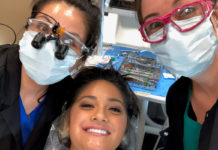
Very rarely do we have an experience so moving, so emotional, that it compels us to dramatically change our behavior. Recently, I had such a breakthrough. Let me share a little background and tell how one short, introductory course made an astounding difference in my practice.
I graduated from dental school in 2001 and started a family practice. After my second year, I had a million-dollar business. While that’s not a big deal today, back then I felt pretty good about my accomplishments. School had taught me the basics, and I was off to an impressive start.
In the beginning I worked on my practice three days a week. I spent two days a week in another practice for guaranteed income. This is when a “wax-up” taught me that I had more—much more—to learn in my field.
Now, I had seen wax-ups before. They generally consisted of gray—or even blue or green—wax teeth on yellow die stone models. May I say that the person who came up with this technique must be related to the guy who can sell Popsicles to Eskimos? Anyway, this wax-up looked incredible to my young, inexperienced eyes. Not only were the white orthodontic models of immaculate quality but the teeth were white, too . . . what a revelation.
My practice exploded
The wax-up led me to Arrowhead Dental Lab and the Dr. Dick Barnes Group. For the next two years I launched myself into their curriculum of courses. I followed the structure Dr. Barnes preaches showing the seven slides, and I implemented the ideas taught. My practice literally exploded—in a good way—and I could see my path to dentistry’s next level.
Today, as an Arrowhead client for over seven years and in practice for nine years, my practice has continued to grow. I have added a partner and will bring on another at the end of 2010.
Fast forward to this year and I will tell you what triggered my latest breakthrough. It was actually precipitated by our country’s economic woes. While my practice has actually had its highest gross production year to date, we have definitely seen our business shift from bigger cases to more routine dental procedures. To maintain our numbers, we have had to increase the volume of clients we see each day.
This trend is not one we want to continue, so I started paying closer attention to the procedures we referred elsewhere. Could I recapture any of these procedures simply by adding to my clinical skills? It had worked before, so why not now?
I signed up to attend the “Over-the-Shoulder” course by Dr. Jim Downs for the third time—he’s a great mentor and I knew he’d update me quickly on the procedure and materials. During the course, Dr. Downs used the Deka laser, a CO2 soft-tissue-only laser, to do all of his soft-tissue adjustments, including a frenectomy.
Everything looked cool, but when I considered the laser’s cost, I just couldn’t pull the trigger on another $50K tool in “this economy.” Dr. Downs asked me to be his wingman at his next Over-the-Shoulder program, and I agreed. I drooled over the Deka laser during this course as well, but I still resisted.
I went home and convinced my partner that we should sign up for the Dental Implants EZ course. I was thinking we could handle “easy implants” to keep people with our practice. Little did I know what lay ahead.
A quick diversion, if I may. As I considered what I should learn, I let my mind drift back to dental school. I hate to say it, but I think the training “brainwashed” us in a sense. We gained experience with certain procedures and instructors, and before long we began defining ourselves by what we felt comfortable with. If an experience seemed beyond our ability, it wasn’t a big deal—that’s what specialists are for.
Implants aren’t that scary
Years later, as general practitioners, only now are we realizing how many procedures we let “walk out the door” for this very reason. While I have admittedly been blessed to work with fantastic specialists who have helped advance my practice, it’s time to get real. Some of the procedures, although scary at first, are not that difficult. Specialists just want me to feel they’re beyond what I can comfortably do. The reality? You and I have been fed some myths like how doing implants is outside the scope of a general dentist. With proper training and techniques these myths simply are not all true.
As I watched Dr. Downs place an implant into the #30 site in 30 minutes—with 20 doctors looking on and asking questions—I was surprised at how easy the procedure looked. I considered how I spend hours designing a full-mouth reconstruction, mounting models, analyzing esthetic components and waiting for wax-ups so I can sell major treatment plans to my patients. Dr. Downs, on the other hand, was doing an $1,800 procedure in 30 minutes. I had to ask myself, “How backward is that? If I can design, present, and then deliver on a huge case, why can’t I place a single implant?”
Dr. Downs did two even more complex cases that morning without even breaking a sweat. The final case surprised me the most. Where based on X-rays I would have gone straight to a combination fixable/removable solution, Dr. Downs chose a different route. He placed four implants—two on each side into the premolar areas and two that required sinus bumps. He did this in an hour and then we went to lunch.
Now, I wasn’t naive enough to think I could do the same thing after a two-day course, but suddenly I found myself thinking, “What if?” I couldn’t sleep that night. I realized how I had allowed the day-to-day drudgery of running a practice, worrying about the economy and dealing with life’s little challenges lull me into being content with simply SURVIVING. Now, patients’ challenges and potential solutions began swirling in my mind. When I got up the next morning, I felt rejuvenated even though I hadn’t slept worth a hoot!
The second day, we learned about bone rejuvenation materials. Suddenly I had a whole new line of possibilities to consider. While I had extracted teeth before, I had never placed a bone graft. If a patient needed an implant, I had referred the extraction and let the specialist decide if the patient needed a graft. The specialist had placed the implant as well.
When the patient finally returned to me, sometimes over a year later, I did get to place the crown. That is, if the patient did make it back or someone had not talked them out of the procedure. It could be frustrating. I would identify the problem, sell the case, and then leave it to someone else to do the procedure and collect the money. As I thought about it more, I had an epiphany: I could do the work! I simply needed proper instruction and training.
To me, the laser was the key. Because the laser created a blood-free working area, Dr. Downs could place implants without making an incision. If I could do the same thing, the laser would justify its cost and I could add procedures to my repertoire. I purchased the laser. Now, in addition to implants, I do periodontal procedures, take biopsies of soft tissue lesions, and enhance my gingival recontouring for cosmetic cases. I’ve even used the laser to remove a wart from my son’s hand!
Before the course, I would refer an implant elsewhere and place the crown at the end. On occasion—and I’m embarrassed to admit this—I would do a bridge instead simply because the month was tight, vacation was coming up, or X-rays had “convinced” me a bridge could be the best solution. I know I’m not alone in this, but it always bothered me. I pride myself on striving to do what’s best for my patients.
Today, I have no need to worry. I do the extraction and place the bone regenerative material. I wait 12-16 weeks and then place the implant. We wait another 12-16 weeks and then bill out the abutment and the implant crown. I receive approximately $4,000 for 2 hours of my time, and that’s just for a single implant! Can you see why I’m excited about this?
Two weeks before my first implant course, I began telling patients I would be learning how to place implants myself. Every single patient—even those who had been reluctant to proceed in the past—said something to the effect of “I’ll just wait until you’re ready” or “You mean I don’t have to go anywhere else anymore?”
The procedure’s cost did not come up . . . not even once. That’s because I already have a relationship with my patients and they believe in me. Suddenly I’m an even better dentist in their eyes!
By the time I finished the course, I had 22 implant patients in mind that would benefit from my training. In my first two days back at the office, I sold eight implants. One of the nicest things? I didn’t need to show a single photograph or make a single presentation on my Casey system. My practice will never be the same.









